 W
WThe AA-52 is one of the first French-produced guns of the post–World War II era. It was manufactured by the French government-owned Manufacture d'armes de Saint-Étienne (MAS) company. The AA-52 is still used today as a vehicle-mounted weapon due to large quantities in service, but has been replaced in the helicopter role by the Belgian FN MAG, starting with the EC 725 Caracal of the special operations units and the Air Force search and rescue teams. The AA-52 had been largely phased out for infantry use in favour of the lighter FN Minimi but remains in use.
 W
WThe AK-63 is a Hungarian variant of the AKM assault rifle manufactured by the Fegyver- és Gépgyár (FÉG) state arms plant in Hungary. It is currently used by the Hungarian Ground Forces as its standard infantry weapon, and by most other branches of the Hungarian Defence Forces.
 W
WThe AK-74 is an assault rifle developed in the early 1970s by Soviet weapons designer Mikhail Kalashnikov to replace the earlier AKM. It uses a smaller 5.45×39mm cartridge, replacing the 7.62×39mm chambering of earlier Kalashnikov-pattern weapons.
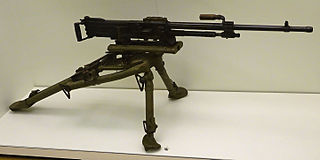 W
WThe Alfa M44 was a Spanish machine gun developed during World War II. At this time, stocks of machine guns ran low and no outside source was available. Non-combatant nations found that the belligerent nations were unable to supply as they were preoccupied with meeting their own wartime production needs. It complimented the ZB-26 light machine gun, and replaced the aging Hotchkiss M1914 machine gun. Originally chambered in 7.92×57mm Mauser, in 1955 an updated version chambered in 7.62×51mm NATO was introduced, and was subsequently issued to Spanish troops, sometimes referred to as the M55. Along with Spain, the M44 was also prominently used by Egypt, whose army had standardised on the 7.92×57mm Mauser round.
 W
WAMD-65 is a Hungarian-manufactured licensed variant of the venerable selective fire AKM rifle for use by that nation's armored infantry and paratrooper ("descent") units within the Hungarian Defence Forces. The rifle's design is suited for outdoor use as an infantry rifle but can also be used from within the confines of an armored vehicle as a fire support weapon. This is possible due to the side-folding stock of shaft design that makes it more compact. The 12.6-inch barrel is also relatively short for the 7.62×39mm cartridge. The operating mechanism does not require a gas expansion chamber at the muzzle, as in the AKS-74U to ensure reliable functioning, but does use a specially designed muzzle brake. It reduces muzzle flash but makes the weapon louder.
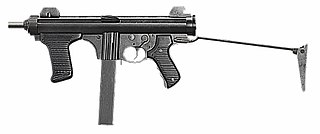 W
WThe Beretta Model 12 is a 9×19mm Parabellum caliber submachine gun designed by Beretta. The production started in 1962, the first users were the Italian Carabinieri, Italian State Police and the Guardia di Finanza even though in limited number, only in 1978 it was widely issued replacing the old Beretta MAB. In 1962 the Italian Army bought a limited number of Franchi LF57 submachine gun, judged better than the M12 but never issued to the troops, and only in 1992 the M12S2 variant was introduced also if in very limited number. The Italian Air Force, instead, bought many M12S and M12S2 for the airport security units. However the weapon had a higher initial success in the Arab countries and South America. Its debut in combat came during the Tet Offensive in 1968 when the US Marines guarding the U.S. embassy in Saigon repelled the assault by the Viet Cong using the Beretta M12. It is also used by various South American, African and Asian countries, and made under licence in Brazil by Taurus, in Belgium by FN Herstal and in Indonesia by PT Pindad.
 W
WThe Cugir machine gun is a gas-operated rotating bolt-locking medium machine gun used by Romanian Land Forces. It can be carried and operated by one person, but an assistant gunner is usually employed. It is available with either a 250-round belt or a 100-round box magazine.
 W
WThe Dragunov sniper rifle is a semi-automatic designated marksman rifle chambered in 7.62×54mmR and developed in the Soviet Union.
 W
WThe FFV 890 was a Swedish assault rifle manufactured and designed by Försvarets Fabriksverk. The FFV 890 was based on the Israeli IMI Galil through a manufacturing licence, which in turn was based on the Finnish Valmet RK 62 and ultimately the Soviet AK-47. The FFV 890 was designed between 1975 and 1980, and its final iteration, FFV 890C, competed in the Swedish Armed Forces trials for the new 5.56×45mm NATO assault rifle, where it ended up as a runner-up to the FN FNC, which was then chosen as the Ak 5. The FFV 890C was never widely adopted by any service, though some rifles were used by the Swedish police.
 W
WThe FN MAG is a Belgian 7.62 mm general-purpose machine gun, designed in the early 1950s at Fabrique Nationale (FN) by Ernest Vervier. It has been used by more than 80 countries and it has been made under licence in several countries, including Argentina, Canada, Egypt, India and the United Kingdom.
 W
WThe FN Minimi is a Belgian 5.56mm Squad Automatic Weapon developed by Ernest Vervier, for FN Herstal. First introduced in the late 1970s, it is now in service in more than 75 countries. The weapon is currently manufactured at the FN facility in Herstal and their U.S. subsidiary FN Manufacturing LLC.
 W
WA Kalashnikov rifle is any one of a series of automatic rifles based on the original design of Mikhail Kalashnikov. They are officially known in Russian as "Avtomát Kaláshnikova", but are widely known as Kalashnikovs, AK47s, or in Russian slang, as a "Kalash." They were originally manufactured in the Soviet Union, primarily by Kalashnikov Concern, formerly Izhmash, but these rifles and their variants are now manufactured in many other countries.
 W
WThe M1 carbine is a lightweight semi-automatic carbine that was a standard firearm for the U.S. military during World War II, the Korean War and well into the Vietnam War. The M1 carbine was produced in several variants and was widely used by not only the U.S. military, but by paramilitary and police forces around the world. It has also been a popular civilian firearm.
 W
WThe M3 is an American .45-caliber submachine gun adopted for U.S. Army service on 12 December 1942, as the United States Submachine Gun, Cal. .45, M3. The M3 was chambered for the same .45 ACP round fired by the Thompson submachine gun, but was cheaper to produce and lighter, although, contrary to popular belief, it was less accurate. This myth stems from a US Army training film portraying the M3 as more accurate than its counterparts. The M3 was commonly referred to as the "Grease Gun" or simply "the Greaser", owing to its visual similarity to the mechanic's tool.
 W
WThe M4 bayonet was introduced in 1944 for use with the M1 carbine. It was built on the M3 fighting knife.
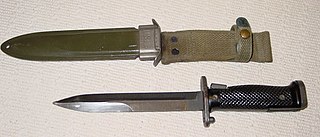 W
WThe M5 Bayonet was adopted by the U.S. military in 1953 to replace other bayonets for the M1 Garand rifle. It uses the M8A1 scabbard.
 W
WThe M16 rifle, officially designated Rifle, Caliber 5.56 mm, M16, is a family of military rifles adapted from the ArmaLite AR-15 rifle for the United States military. The original M16 rifle was a 5.56mm automatic rifle with a 20-round magazine.
 W
WThe M31 HEAT is a fin-stabilized anti-tank rifle grenade designed in the late 1950s to replace the Belgian ENERGA rifle grenade which was adopted by the US Army and US Marines as an emergency stop-gap measure during the Korean War. Like the ENERGA, it has a nose-initiated, based-detonated HEAT warhead, but unlike the ENERGA, the mechanical impact fuse system is replaced with a less complex and more reliable piezo-electric fuse system which also allows higher angles of impact, up to 65 degrees.
 W
WThe M49 submachine gun is a Yugoslavian submachine gun chambered in 7.62×25mm Tokarev, designed for use with the Yugoslav People's Army. While externally similar to the PPSh-41, as well as being able to interchange magazines, the M49 is actually very different in both construction and design. More similar in nature to the Italian Beretta Model 38, the M49 features a one-piece tube receiver which contains the bolt, recoil spring and buffer mechanism. Constructed of machined parts as well as simple tubing, the receiver assembly incorporates a ventilated barrel shroud to protect the operator from being burned during periods of rapid-fire, as well as a simple muzzle brake to steady the weapon.
 W
WThe M73 and M219 are 7.62 mm NATO caliber machine guns designed for tank use. NATO no longer uses them, but they were used on the M48 Patton and M60 Patton MBT series, aswell as the MBT-70 prototype vehicles, and on the M551 Sheridan Armored Reconnaissance / Airborne Assault Vehicle (AR/AAV).
 W
WThe MAC 50 is a standard semi-automatic pistol of the French army and adopted in 1950. It replaced the previous series of French pistols, the Modèle 1935A & Modèle 1935S, and was produced between 1950 and 1970.
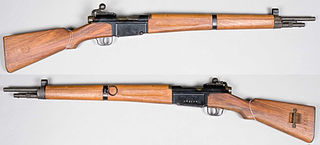 W
WThe MAS Modèle 36 is a military bolt-action rifle. First adopted in 1936 by France and intended to replace the Berthier and Lebel series of service rifles, it saw service long past the World War II period. It was manufactured from late 1937 onward by Manufacture d'Armes de Saint-Étienne (MAS), one of several government-owned arms factories in France. Only 250,000 MAS-36 rifles were available to equip the French infantry during the Battle of France in 1940. Mass production finally caught up after World War II and MAS-36 rifles became widely used in service during the First Indochina War, the Algerian War and the Suez Crisis. Altogether, about 1.1 million MAS-36 rifles had been manufactured when production ceased in 1952.
 W
WThe MAS-49 is a French semi-automatic rifle that replaced various bolt action rifles as the French service rifle that was produced from 1949. It was designed and manufactured by the government-owned MAS arms factory. The French Army formal designation of the MAS-49 is Fusil semi-automatique 7 mm 5 M. 49.
 W
WThe MAT-49 was a submachine gun which was developed by French arms factory Manufacture Nationale d'Armes de Tulle (MAT) for use by the French Army and was first produced in 1949.
 W
WThe New Nambu M57 (ニューナンブM57) is a series of semi-automatic pistols designed by Shin-Chuō Industries, later merged with Minebea. "New Nambu" was named after Kijirō Nambu, a notable firearm designer and the founder of Shin-Chuō Industries.
 W
WThe PK, is a 7.62×54mmR general-purpose machine gun designed in the Soviet Union and currently in production in Russia. The original PK machine gun was introduced in 1961 and then the improved PKM in 1969 to replace the SGM and RP-46 machine guns in Soviet service. It remains in use as a front-line infantry and vehicle-mounted weapon with Russia's armed forces. The PK has been exported extensively and produced in several other countries under license.
 W
WThe PPS is a family of Soviet submachine guns chambered in 7.62×25mm Tokarev, developed by Alexei Sudayev as a low-cost personal defense weapon for reconnaissance units, vehicle crews and support service personnel.
 W
WThe Rasheed is a semi-automatic carbine, derived from the Hakim Rifle and used by the Egyptian military. Only around 8,000 were made.
 W
WThe MG 3 is a German general-purpose machine gun chambered for the 7.62×51mm NATO cartridge. The weapon's design is derived from the World War II era MG 42 universal machine gun that fired the 7.92×57mm Mauser round.
 W
WThe RK 62, officially 7.62 RK 62 and commercially M62, is an assault rifle manufactured by Valmet and Sako. It is the standard issue infantry weapon of the Finnish Defence Forces.
 W
WThe RL-83 Blindicide is primarily an antitank rocket launcher, but other rockets can be fired. It was produced by Mecar SA of Belgium and was an improved derivative of the M20A1 Bazooka. Its name translates to "armor killer", derived from the French "blindé" and the suffix -cide meaning to kill.
 W
WThe RPD is a 7.62mm light machine gun developed in the Soviet Union by Vasily Degtyaryov for the 7.62×39mm M43 intermediate cartridge. It was created as a replacement for the DP machine gun chambered for the 7.62×54mmR round. It is a precursor of most squad automatic weapons. It was succeeded in Soviet service by the RPK.
 W
WThe SG-43 Goryunov was a Soviet medium machine gun that was introduced during the Second World War. It was chambered for the 7.62×54mmR cartridge, and was introduced in 1943 as a replacement for the older M1910 Maxim machine guns. It was mounted on wheeled mounts, tripods and armored vehicles.
 W
WThe Škorpion vz. 61 is a Czechoslovak machine pistol developed in 1959 by Miroslav Rybář (1924–1970) and produced under the official designation Samopal vzor 61 by the Česká zbrojovka arms factory in Uherský Brod from 1963 to 1979.
 W
WThe SKS is a Soviet semi-automatic carbine chambered for the 7.62×39mm round, designed in 1943 by Sergei Gavrilovich Simonov. Its complete designation, SKS-45, is an initialism for Samozaryadny Karabin sistemy Simonova, 1945. The SKS is an extremely reliable, simply constructed weapon with two unique distinguishing characteristics: a permanently attached folding bayonet, and a hinged non-detachable magazine. However, it is incapable of fully automatic fire and limited by its ten round magazine capacity, and was rendered obsolete by the introduction of the AK-47 in the 1950s. The SKS was only briefly a standard infantry weapon in front-line units of the Soviet Armed Forces before being replaced by the AK-47.
 W
WThe Smith & Wesson M76 submachine gun (SMG) was produced by Smith & Wesson from 1967 to 1974.
 W
WThe Sumitomo NTK-62 is the standard issue General-purpose machine gun of the Japan Self-Defense Forces, known as the Type 62 GPMG. When first issued it fulfilled both light and medium machine gun support throughout the JGSDF. Though the Sumitomo Heavy Industries' M249 firing the smaller 5.56×45mm NATO cartridge has largely replaced it in the light machine gun role at the squad level in the JGSDF, the Type 62 still plays the support role at platoon and company level for the infantry as a Medium machine gun firing the more powerful 7.62×51mm NATO cartridge. It also continues to be used as a co-axial weapon in various armored vehicles, including tanks and APCs.
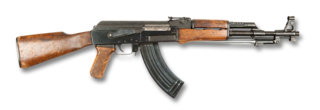 W
WThe Type 56 is a Chinese 7.62×39mm rifle. It is a variant of the Soviet-designed AK-47 and AKM rifles. Production started in 1956 at State Factory 66 but was eventually handed over to Norinco and PolyTech, who continue to manufacture the rifle primarily for export.
 W
WThe Type 58 is an assault rifle made in North Korea derived from the Soviet AK-47 designed by Mikhail Kalashnikov. This was the first weapon made in North Korea alongside the PPSh-41, made under license as the Type 49. It was made in Factory 61 and 65 in Chongjin.
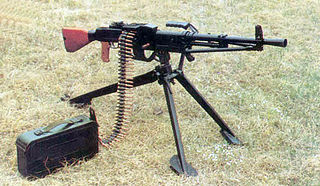 W
WThe Type 67 is a general-purpose machine gun, chambered in 7.62×54mmR used by the Chinese People's Liberation Army.
 W
WThe Type 81 is a Chinese-designed second-generation, selective-fire, gas-operated 7.62×39mm rifle adopted by the Chinese People's Liberation Army (PLA) and has been in service since the mid-1980s.
 W
WThe Universal Machine Gun Model 1959 is a general-purpose machine gun developed in Czechoslovakia in the 1950s. It remains in use by the Czech Army and the Slovak Armed Forces.
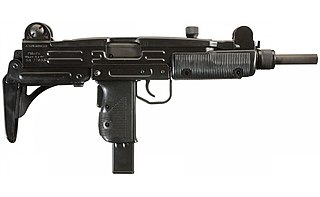 W
WThe Uzi is a family of Israeli open-bolt, blowback-operated submachine guns. The Uzi was one of the first weapons to use a telescoping bolt design which allows the magazine to be housed in the pistol grip for a shorter weapon.
 W
WThe R4 is a South African 5.56×45mm assault rifle. It entered service as the standard service rifle of the South African Defence Force (SADF) in 1980. The R4 replaced the R1, a variant of the 7.62×51mm FN FAL. It was produced by Lyttelton Engineering Works, now Denel Land Systems.
 W
WThe Vektor SS-77 is a general-purpose machine gun designed and manufactured by Denel Land Systems—formerly Lyttleton Engineering Works (LIW)—of South Africa.
 W
WThe vz. 52 is a Czechoslovak light machine gun developed after the Second World War for the Czechoslovak Armed Forces.
 W
WThe vz. 52 rifle is a self-loading rifle developed shortly after the Second World War in Czechoslovakia. Its full name is 7,62mm samonabíjecí puška vzor 52. Vz. 52 is an abbreviation for vzor 52, meaning "model 52". It fires the unique 7.62×45mm cartridge. It is considered both reliable and accurate. The first 5000 vz. 52 rifles were made by Považské strojárne in Považská Bystrica, but due to production difficulties, its manufacture was taken over by Česká zbrojovka Uherský Brod.
 W
WThe vz. 58 is a 7.62×39mm rifle designed and manufactured in Czechoslovakia and accepted into service in the late 1950s as the 7,62 mm samopal vzor 58, replacing the vz. 52 self-loading rifle and the 7.62×25mm Tokarev Sa 24 and Sa 26 submachine guns.
 W
WThe Zastava M72 is a light machine gun developed and manufactured by then Yugoslav Zastava Arms company. Generally, the M72 is almost a direct copy of the Soviet RPK light machine gun, the only visual differences being in barrel, wooden stock, no side rail mount and slightly in design of the wooden handguard.
 W
WThe Zastava M76 is a military semi-automatic designated marksman rifle developed and manufactured by Zastava Arms.